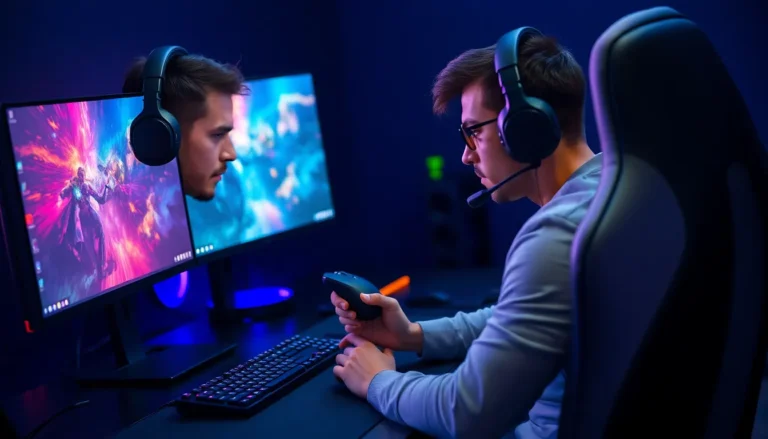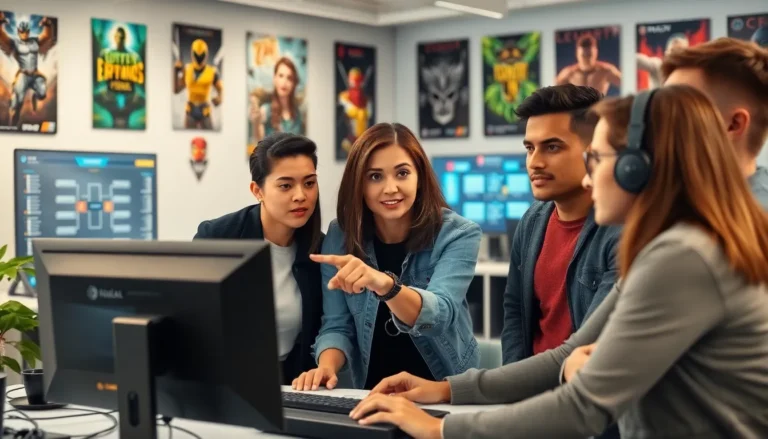Serious game development is transforming the way industries approach training, education, and problem-solving. By blending entertainment with purpose, these games engage users in immersive experiences that foster learning and skill acquisition. As technology advances, the potential for serious games to address real-world challenges continues to grow.
From corporate training programs to healthcare simulations, serious games offer innovative solutions that captivate audiences while delivering impactful results. They encourage collaboration, critical thinking, and creativity, making them invaluable tools in various sectors. As the demand for effective learning methods rises, understanding the nuances of serious game development becomes essential for creators and organizations alike.
Table of Contents
ToggleOverview of Serious Game Development
Serious game development focuses on creating games designed with specific objectives beyond entertainment. These games enhance engagement in various fields, including education, training, and health.
Definition and Purpose
Serious games are interactive experiences with goals aimed at teaching concepts, improving skills, or solving real-world problems. They address practical challenges by merging gameplay mechanics with serious content. For example, simulations in healthcare provide essential practice for medical professionals while allowing players to make decisions in realistic scenarios. The primary aim is to foster learning and development through engaging, immersive experiences.
Key Characteristics
Serious games possess distinct characteristics that set them apart from traditional games:
- Interactivity: Players actively engage with the content, contributing to their learning experience.
- Educational Content: The integration of knowledge and skill-building elements ensures players acquire relevant information.
- Simulation: Serious games often recreate real-world situations, allowing players to analyze and respond to challenges.
- Feedback Mechanisms: Constructive feedback provides players with immediate performance assessments, promoting growth.
- Collaborative Elements: Many serious games include multiplayer options that encourage teamwork and communication.
- Measurable Outcomes: Developers design serious games to track player progress, allowing for data analysis and improvement over time.
These characteristics contribute to the effectiveness of serious games as tools for enhancing learning and performance across multiple sectors.
Historical Context

Serious game development has evolved significantly over the decades, reflecting changes in technology and educational needs. This section outlines the evolution of serious games and highlights key milestones in their development.
Evolution of Serious Games
Serious games emerged with roots in military training and education during the 1960s. Initial efforts focused on simulation-based training programs, utilizing rudimentary graphics to create immersive environments. As technology advanced, the inclusion of computers transformed serious games, introducing more engaging formats and sophisticated narratives. By the 1990s, the advent of the internet enabled multiplayer capabilities, further enhancing collaborative learning experiences.
In the 2000s, developers recognized the potential of serious games in various industries, including healthcare and corporate training. The integration of game mechanics with educational objectives became prevalent, as did research into their effectiveness. Today, serious games encompass various platforms and genres, offering diverse opportunities for skill enhancement and knowledge retention.
Milestones in Development
Several significant milestones marked the progression of serious game development:
| Year | Milestone | Description |
|---|---|---|
| 1962 | “SIMNET” | The U.S. Army developed this simulator for virtual military training, serving as an early model for serious games. |
| 1980 | “The Oregon Trail” | This educational game taught students about pioneer life and American history, highlighting the potential for learning through gameplay. |
| 1994 | “Virtual Reality Therapy” | Use of VR in clinical settings began, demonstrating serious games’ application in therapy and rehabilitation. |
| 2006 | “Re-Mission” | This serious game for cancer patients encouraged treatment adherence and informed patients about their illness. |
| 2010 | “World of Warcraft: The Guilds of The Blackrock” | This game incorporated educational elements and teamwork to demonstrate group dynamics and strategy. |
These milestones contributed to the recognition of serious games as effective tools for education and training, underscoring their ability to address real-world challenges.
Design Principles
Design principles play a crucial role in effective serious game development. They ensure that games meet educational goals while engaging users. Understanding these principles enhances the creation of impactful serious games.
Learning Objectives
Learning objectives define the specific skills or knowledge participants should acquire through gameplay. Clear objectives should align with real-world applications to ensure relevance. For instance, a serious game aimed at improving teamwork might set objectives around communication, collaboration, and conflict resolution. By establishing measurable learning outcomes, developers can assess the game’s effectiveness and make necessary adjustments.
User Engagement Strategies
User engagement strategies enhance player motivation and involvement. Key strategies include:
- Interactivity: Incorporating interactive elements keeps players invested in the learning process. Choices and branching narratives can increase decision-making skills.
- Feedback: Providing timely, constructive feedback helps players understand their progress and areas for improvement. Instant feedback facilitates a learning loop, allowing adjustments in strategy.
- Incentives: Reward systems encourage players to achieve mastery. Points, badges, or unlockable content can drive motivation and engagement.
- Social Interaction: Including collaborative elements fosters interaction among players. Group challenges or teamwork scenarios strengthen learning and community.
- Narrative: Engaging narratives create emotional connections. A well-crafted story can enhance retention and deepen understanding of the content.
Implementing these strategies effectively enhances the educational impact of serious games, ensuring they meet both learning objectives and user engagement needs.
Technologies Used
Serious game development relies on various technologies that enhance the creation, delivery, and effectiveness of these interactive experiences. Key advancements in software and hardware significantly contribute to the development of innovative serious games.
Game Engines
Game engines serve as the backbone of serious game development, providing the necessary tools for building interactive environments. Commonly used engines include:
- Unity: Offers flexibility and a comprehensive set of features for 2D and 3D game development. It supports multiple platforms, enabling developers to reach diverse audiences effectively.
- Unreal Engine: Known for high-quality graphics and robust simulation capabilities. It focuses on realism, making it suitable for healthcare simulations and training scenarios.
- Godot: An open-source engine that allows for rapid prototyping and customization. Its lightweight nature attracts developers aiming for efficient and unique serious games.
These engines facilitate rapid iteration and testing, ensuring that game mechanics align with educational objectives.
Educational Tools
Educational tools play a crucial role in the design and implementation of serious games. They enable developers to integrate learning principles seamlessly into gameplay. Key tools include:
- Learning Management Systems (LMS): Platforms like Moodle or Canvas manage educational content delivery, enhance tracking of user progress, and provide analytics for improvement.
- Assessment Software: Tools that evaluate player performance, providing insights into learning outcomes and areas needing reinforcement. Programs like Kahoot! and Quizlet enhance engagement through interactive quizzes.
- Simulation Software: Solutions like Articulate Storyline and Adobe Captivate provide opportunities for creating immersive educational experiences through scenario-based learning.
These tools empower developers to align gameplay mechanics with educational principles, promoting effective learning outcomes.
Applications of Serious Games
Serious games find extensive application across multiple sectors, enhancing learning, training, and problem-solving through engaging interactive experiences.
Education and Training
Serious games contribute significantly to education and training by promoting active learning and retention. These games foster critical thinking and problem-solving skills in learners, allowing them to apply concepts in safe, simulated environments. For example, simulations in subjects like biology or physics enable students to experiment and explore outcomes without real-world consequences. Additionally, adaptive learning environments tailor experiences to individual needs, ensuring effective learning paths. The integration of assessment tools within serious games allows educators to monitor progress, providing real-time feedback and facilitating personalized instruction.
Health and Therapy
Serious games serve as powerful tools in health and therapy settings. They offer innovative approaches to patient rehabilitation, mental health therapies, and medical training. For instance, virtual reality (VR) games enable physical therapy patients to engage in exercises while distracting them from discomfort. Additionally, serious games help in cognitive behavioral therapy by allowing individuals to confront fears and practice coping strategies in controlled environments. Medical professionals use serious games for training, enhancing skills through realistic patient interactions, improving decision-making in critical situations.
Corporate Training
Serious games play a vital role in corporate training by delivering engaging, interactive content that promotes skill development. These games simulate real-world challenges, allowing employees to practice critical skills like teamwork and leadership in a low-risk environment. Companies utilize gamified scenarios for onboarding, compliance training, and soft skills development, enhancing retention and applying knowledge to job performance. Data analytics from these platforms provide insights into employee progress, facilitating targeted coaching and support.
Challenges in Serious Game Development
Serious game development faces several challenges that can hinder the creation of effective and engaging educational tools. Two primary hurdles include funding and budget constraints, as well as the challenge of balancing fun and learning.
Funding and Budget Constraints
Funding and budget constraints significantly affect serious game development. Limited financial resources can restrict access to advanced technology, skilled personnel, and research necessary for high-quality production. Developers often rely on grants, sponsorships, or partnerships with educational institutions and organizations. Lack of adequate funding can lead to reduced development time, lower quality graphics, and limited testing processes, which negatively impact the learning experience. According to a report from the Games for Change organization, around 30% of serious game developers cite budget limitations as a major barrier to their projects.
Balancing Fun and Learning
Balancing fun and learning presents a critical challenge in serious game development. Developers must create engaging game mechanics while ensuring that educational objectives remain front and center. Overemphasis on entertainment can dilute the game’s educational value, while focusing solely on teaching may result in a lackluster experience for players. Striking the right balance requires careful design and iterative testing to ensure that both entertainment and educational goals are met effectively. Research from the International Journal of Game-Based Learning indicates that games incorporating both elements show significant improvements in learner retention and engagement.
Future Trends
Serious game development continues to evolve, driven by new technologies and market demands. Organizations are increasingly recognizing the value of serious games, leading to significant growth across various sectors.
Emerging Technologies
Artificial intelligence (AI) enhances personalization and adaptability in serious games. Developers integrate AI to tailor learning experiences based on user performance and preferences. Virtual reality (VR) and augmented reality (AR) technologies promote immersive learning environments, allowing players to engage in realistic scenarios. Blockchain technology offers secure and transparent solutions for tracking user progress and validating achievements, improving trust and accountability. Cloud computing supports scalable applications, enabling easy access to serious games from multiple devices.
Market Growth and Opportunities
The serious game market has shown substantial growth, projected to reach $20 billion by 2025, according to industry reports. Education and corporate training sectors drive demand for engaging learning solutions, while healthcare applications expand the market further. Increased investment from venture capitalists and government grants supports innovative serious game projects. Collaboration between educational institutions, game developers, and healthcare organizations fosters the development of tailored solutions that address specific industry needs. As industries adapt, serious games present unique opportunities for learning and skill development.
Serious game development is reshaping how industries approach training and education. By merging engaging gameplay with meaningful objectives, these games provide powerful tools for skill enhancement and problem-solving. As technology continues to evolve, developers have the opportunity to create more immersive and effective learning experiences.
The potential applications across various sectors are vast, making serious games a crucial component in modern education and training strategies. With ongoing advancements in AI, VR, and AR, the future looks promising. Embracing these innovations will enable organizations to harness the full potential of serious games, ensuring they meet both educational goals and user engagement needs.





